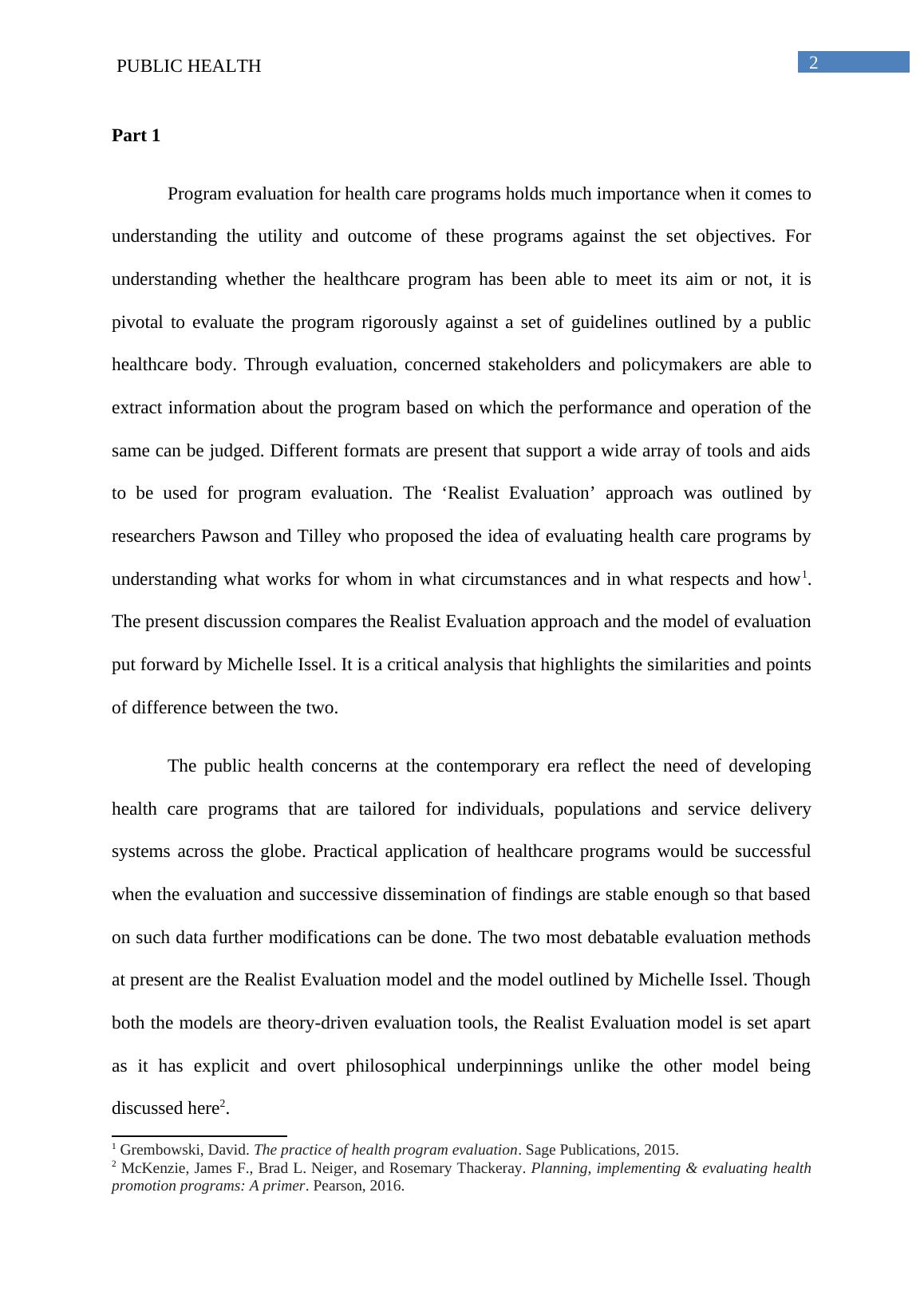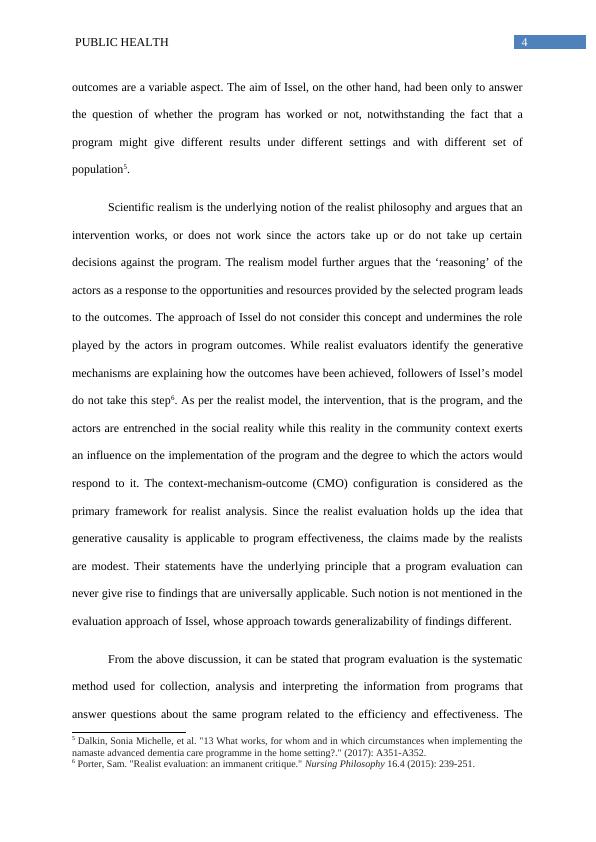Part 1 Program Evaluation for Health Care Programs
13 Pages3307 Words255 Views
Added on 2020-04-07
About This Document
12 PUBLIC HEALTH PUBLIC HEALTH 1 Public Health Name of student: Name of university: per Author note: Part 1 Program evaluation for health care programs holds much importance when it comes to understanding the utility and outcome of these programs against the set objectives. The ‘Realist Evaluation’ approach was outlined by researchers Pawson and Tilley who proposed the idea of evaluating health care programs by understanding what works for whom in what circumstances and in what respects and how.
Part 1 Program Evaluation for Health Care Programs
Added on 2020-04-07
ShareRelated Documents
1Running head: PUBLIC HEALTHPublic Health Name of student:Name of university:Author note:

2 PUBLIC HEALTH Part 1Program evaluation for health care programs holds much importance when it comes tounderstanding the utility and outcome of these programs against the set objectives. Forunderstanding whether the healthcare program has been able to meet its aim or not, it ispivotal to evaluate the program rigorously against a set of guidelines outlined by a publichealthcare body. Through evaluation, concerned stakeholders and policymakers are able toextract information about the program based on which the performance and operation of thesame can be judged. Different formats are present that support a wide array of tools and aidsto be used for program evaluation. The ‘Realist Evaluation’ approach was outlined byresearchers Pawson and Tilley who proposed the idea of evaluating health care programs byunderstanding what works for whom in what circumstances and in what respects and how1.The present discussion compares the Realist Evaluation approach and the model of evaluationput forward by Michelle Issel. It is a critical analysis that highlights the similarities and pointsof difference between the two. The public health concerns at the contemporary era reflect the need of developinghealth care programs that are tailored for individuals, populations and service deliverysystems across the globe. Practical application of healthcare programs would be successfulwhen the evaluation and successive dissemination of findings are stable enough so that basedon such data further modifications can be done. The two most debatable evaluation methodsat present are the Realist Evaluation model and the model outlined by Michelle Issel. Thoughboth the models are theory-driven evaluation tools, the Realist Evaluation model is set apartas it has explicit and overt philosophical underpinnings unlike the other model beingdiscussed here2.1Grembowski, David.The practice of health program evaluation. Sage Publications, 2015.2McKenzie, James F., Brad L. Neiger, and Rosemary Thackeray.Planning, implementing & evaluating healthpromotion programs: A primer. Pearson, 2016.

3 PUBLIC HEALTH The common element between the Realist Evaluation model and the model outlinedby Michelle Issel is that both use the well-established program theory as the basis of theirevaluation. The theory is a conceptual model that aims to justify how the selectedintervention, in the form of a project, program, strategy or policy, contributes to the resultsproduced by the actual or intended impacts. It includes both negative and positive impactsand highlights other factors contributing to impacts3. Both the Realist Evaluation model andMichelle Issel’s model have the objective of assessing whether the program is designed in amanner so that the intended outcomes can be achieved. The theory becomes the backbone ofthe programs, and it lays out a clear, logical description of the reasons behind the activitiesleading to results of benefits. Both the evaluation approaches clarify the agreement about howthe program being evaluated works and identifies the gaps in the evidence.The first realist evaluation approach was developed by Pawson and Tilley who arguedthat in order to understand what the actual outcomes of a health program are; the decisionmakers must identify the effectiveness of the program keeping in mind the population itaddresses and the circumstances under which it has been implemented. The main focus ofthis type of evaluation is to examine what elements of the chosen program have beensuccessful in bringing about the outcomes given the corresponding circumstances and whohave been affected by the program4. In contrast, the evaluation approach of Issel had beenfocusing on the sole understanding of whether the program has worked or not. While Pawsonand Tilley have attempted to justify the fact that a program might be successful under certaincircumstances and not be successful under other, Issel has not considered this aspect ofprogram evaluation in his model. Realist evaluation model keeps into consideration thecontexts in which the program might have given different results, assuming that program3Issel, L. Michele, and Rebecca Wells.Health program planning and evaluation. Jones & Bartlett Learning,2017.4Pawson, R., and N. Tilley. "Realist evaluation. 2004." (2015).

4 PUBLIC HEALTH outcomes are a variable aspect. The aim of Issel, on the other hand, had been only to answerthe question of whether the program has worked or not, notwithstanding the fact that aprogram might give different results under different settings and with different set ofpopulation5.Scientific realism is the underlying notion of the realist philosophy and argues that anintervention works, or does not work since the actors take up or do not take up certaindecisions against the program. The realism model further argues that the ‘reasoning’ of theactors as a response to the opportunities and resources provided by the selected program leadsto the outcomes. The approach of Issel do not consider this concept and undermines the roleplayed by the actors in program outcomes. While realist evaluators identify the generativemechanisms are explaining how the outcomes have been achieved, followers of Issel’s modeldo not take this step6. As per the realist model, the intervention, that is the program, and theactors are entrenched in the social reality while this reality in the community context exertsan influence on the implementation of the program and the degree to which the actors wouldrespond to it. The context-mechanism-outcome (CMO) configuration is considered as theprimary framework for realist analysis. Since the realist evaluation holds up the idea thatgenerative causality is applicable to program effectiveness, the claims made by the realistsare modest. Their statements have the underlying principle that a program evaluation cannever give rise to findings that are universally applicable. Such notion is not mentioned in theevaluation approach of Issel, whose approach towards generalizability of findings different. From the above discussion, it can be stated that program evaluation is the systematicmethod used for collection, analysis and interpreting the information from programs thatanswer questions about the same program related to the efficiency and effectiveness. The5Dalkin, Sonia Michelle, et al. "13 What works, for whom and in which circumstances when implementing thenamaste advanced dementia care programme in the home setting?." (2017): A351-A352.6Porter, Sam. "Realist evaluation: an immanent critique."Nursing Philosophy16.4 (2015): 239-251.

End of preview
Want to access all the pages? Upload your documents or become a member.
Related Documents
Evaluation Plan for Promotional Program of Crying Cliniclg...
|12
|875
|234
Program Planning and Evaluation in Public Healthlg...
|8
|1905
|43
Hierarchy and Power: Australian Health Care Systemlg...
|12
|3745
|227
UnitedHealthcare: Health insurance plans| Docslg...
|11
|3829
|21
Effective Planning and Evaluation In Environmental Health Contextslg...
|11
|2649
|59
